[electromagnetic induction] generator effect
1/27
Earn XP
Description and Tags
[ BBC Bitesize 'Magnetism and electromagnetism ⇢ Electromagnetic Induction' page 1-4 ]
Name | Mastery | Learn | Test | Matching | Spaced |
|---|
No study sessions yet.
28 Terms
Electromagnetic Induction
The production of a potential difference (voltage) when a conductor, such as a wire, is moved through a magnetic field or exposed to a varying magnetic field. If the conductor is part of an electric circuit, an induced current will flow.
The Generator Effect
When motion between a conductor and a magnetic field creates electricity, ie a magnet is moved into a coil of wire.
Induced voltage produces…
… induced current in complete circuit. This induced current generates a magnetic field, which opposes the original change.
ex. moving a magnet into a coil induces magnetic field that repels magnet. This effect occurs when magnet is moved into coil or coil moved around magnet.
The direction of the induced current depends on the direction of movement of the magnet relative to the coil. The current is reversed when:
the magnet is moved out of the coil
the other pole of the magnet is moved into the coil
An induced potential difference or induced current will increase if:
the speed of movement is increased
the magnetic field strength is increased
the number of turns on the coil is increased
Generator
Device that converts kinetic energy into electrical energy.
AC Generator
A device that produces a potential difference, a simple design consists of a coil of wire rotating in a magnetic field and 2 slip rings. eg. alternator
Alternator
A type of AC generator which produces alternating current.
Simple Alternator Working:
the coil is rotated in the magnetic field
current is induced in the rotating coil
slip rings connected to the coil
brushes make continuous contact between the external circuit and the slip rings
current flows in external circuit
Slip rings maintain constant contact with the same sides of the coil
Alternator Producing an AC:
coil movement through magnetic field induces potential difference
upward movement induces potential difference in one direction.
downward movement reverses induced potential difference
alternator produces constantly changing current, resulting current is AC
Output of an Alternator on a Graph:
An alternating sine curve.
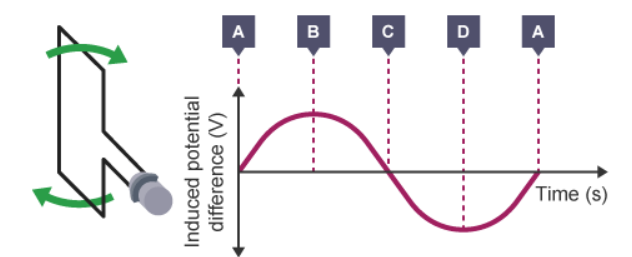
The maximum potential difference or current can be increased by:
increasing the rate of rotation
increasing the strength of the magnetic field
increasing the number of turns on the coil
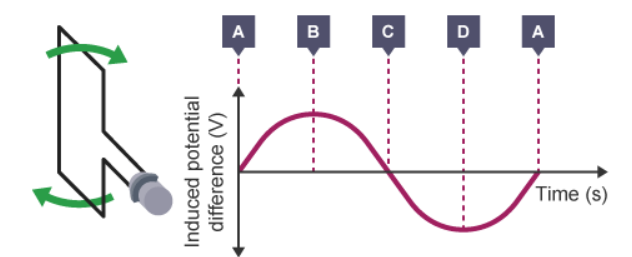
A → the coil is at 0°
The coil is moving parallel to the direction of the magnetic field, so no potential difference is induced.

B → the coil is at 90°
The coil is moving at 90° to the direction of the magnetic field, so the induced potential difference is at its maximum.
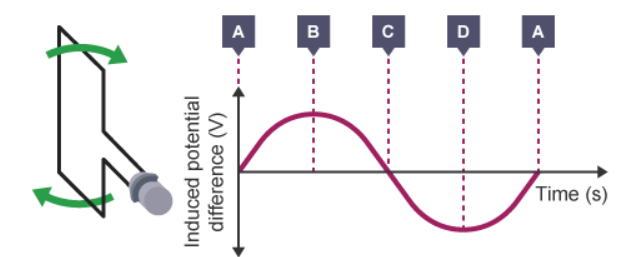
C → the coil is at 180
The coil is now moving parallel to the direction of the magnetic field, so no potential difference is induced.
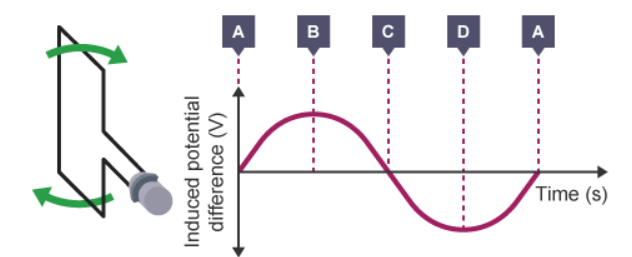
D → the coil is at 270°
The coil is moving at 90° to the direction of the magnetic field, so the induced potential difference is at its maximum. Here, the induced potential difference travels in the opposite direction to what it did at B.

A → the coil is at 360°
The coil is back at its starting point, having done a full rotation. The coil is moving parallel to the direction of the magnetic field, so no potential difference is induced.
DC Generator
A device that produces a potential difference, a simple design consists of a coil of wire rotating in a magnetic field and a split ring commutator. eg. dynamo
Dynamo
A type of DC generator which produces direct current.
Dynamo Producing a DC:
dynamo uses split ring commutator to change coil connections every half turn
connections reversed as induced potential difference changes direction
ensures current to external circuit flows consistently in one direction
Output of a Dynamo on a Graph:
A sine curve that stays in the same direction all the time.
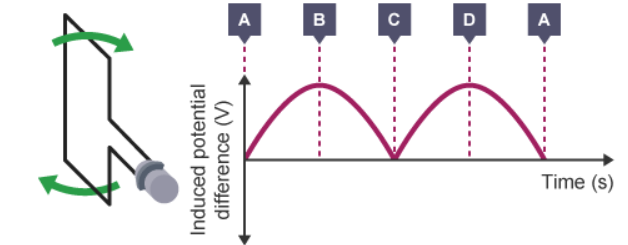
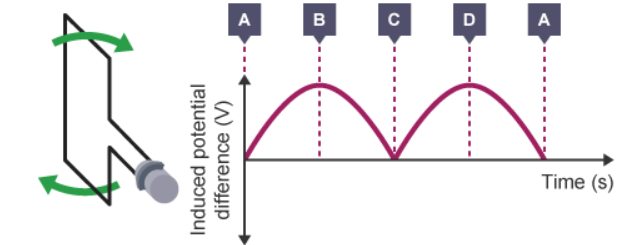
A → the coil is at 0°
The coil is moving parallel to the direction of the magnetic field, so no potential difference is induced.
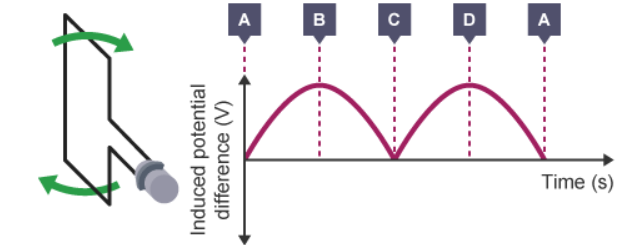
B → the coil is at 90°
The coil is moving at 90° to the direction of the magnetic field, so the induced potential difference is at its maximum.
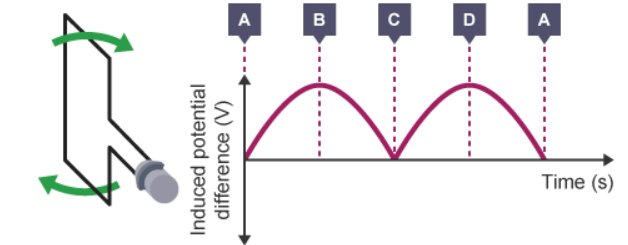
C → the coil is at 180
The coil is now moving parallel to the direction of the magnetic field, so no potential difference is induced.
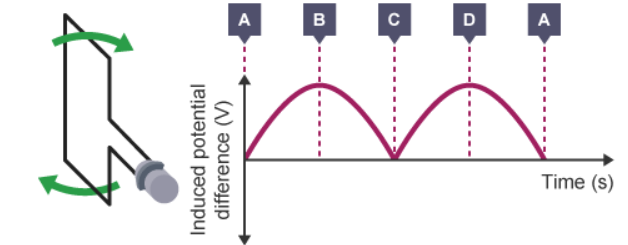
D → the coil is at 270°
The coil is moving at 90° to the direction of the magnetic field, so the induced potential difference is at its maximum. Here, the induced potential difference travels in the opposite direction to what it did at B.
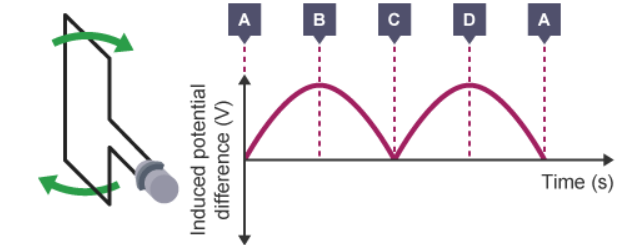
A → the coil is at 360°
The coil is back at its starting point, having done a full rotation. The coil is moving parallel to the direction of the magnetic field, so no potential difference is induced.
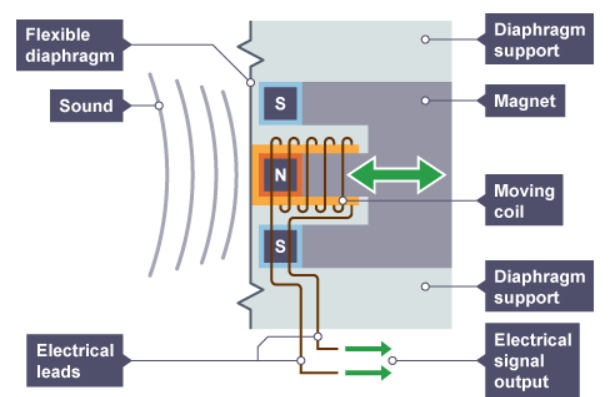
Moving-coil Microphone
A microphone in which electrical signals are produced when the pressure variations in sound waves vibrate a coil of wire within a magnetic field. They use the generator effect to induce a changing current from the pressure variations of sound waves.
In a moving-coil microphone:
pressure variations in sound waves cause the flexible diaphragm to vibrate
the vibrations of the diaphragm cause vibrations in the coil
the coil moves relative to a permanent magnet, so a potential difference is induced in the coil
the coil is part of a complete circuit, so the induced potential difference causes a current to flow around the circuit
the changing size and direction of the induced current matches the vibrations of the coil
the electrical signals generated match the pressure variations in the sound waves